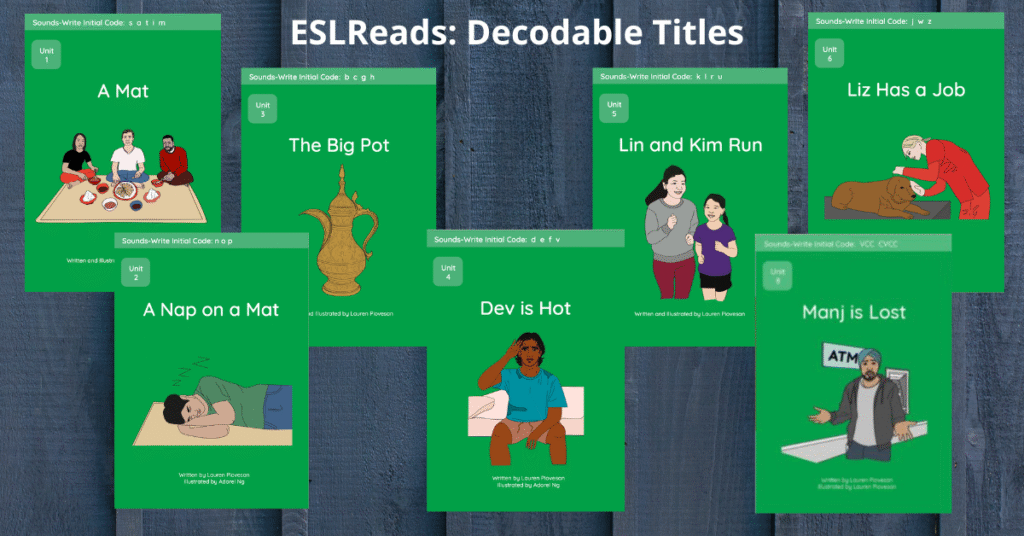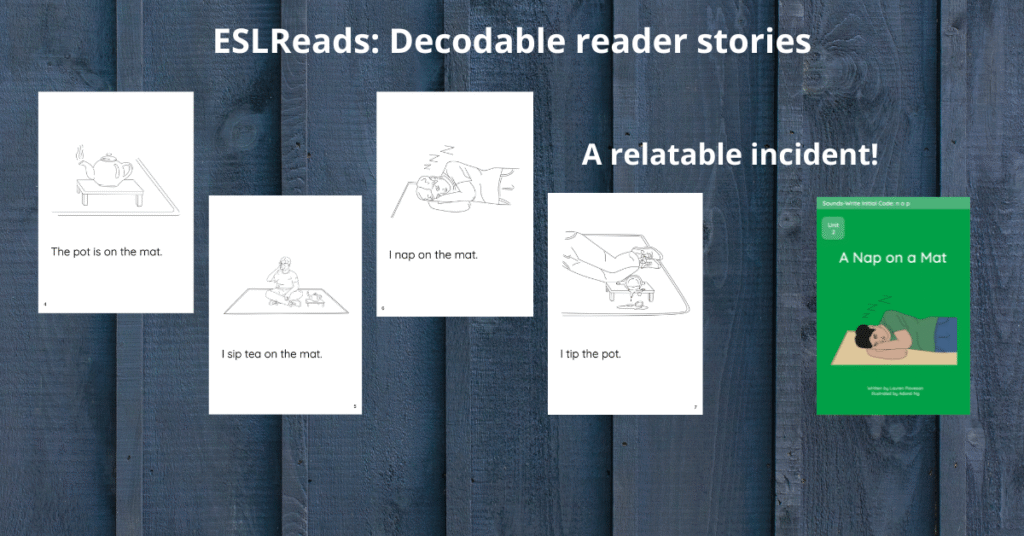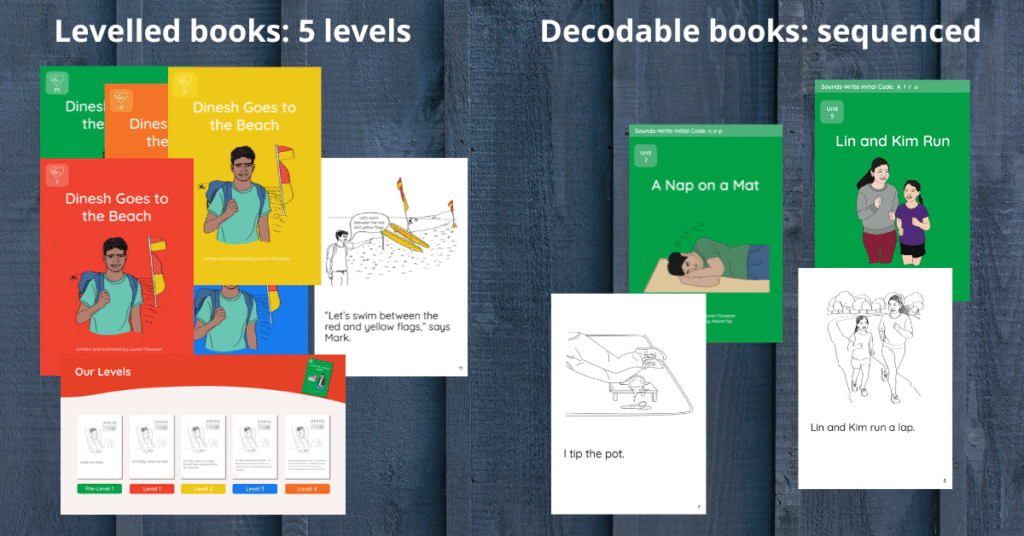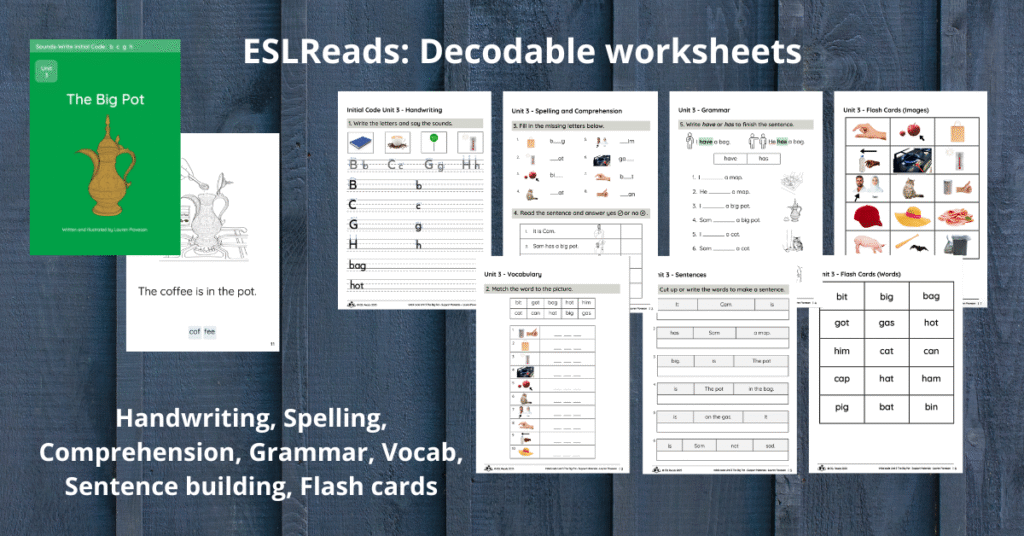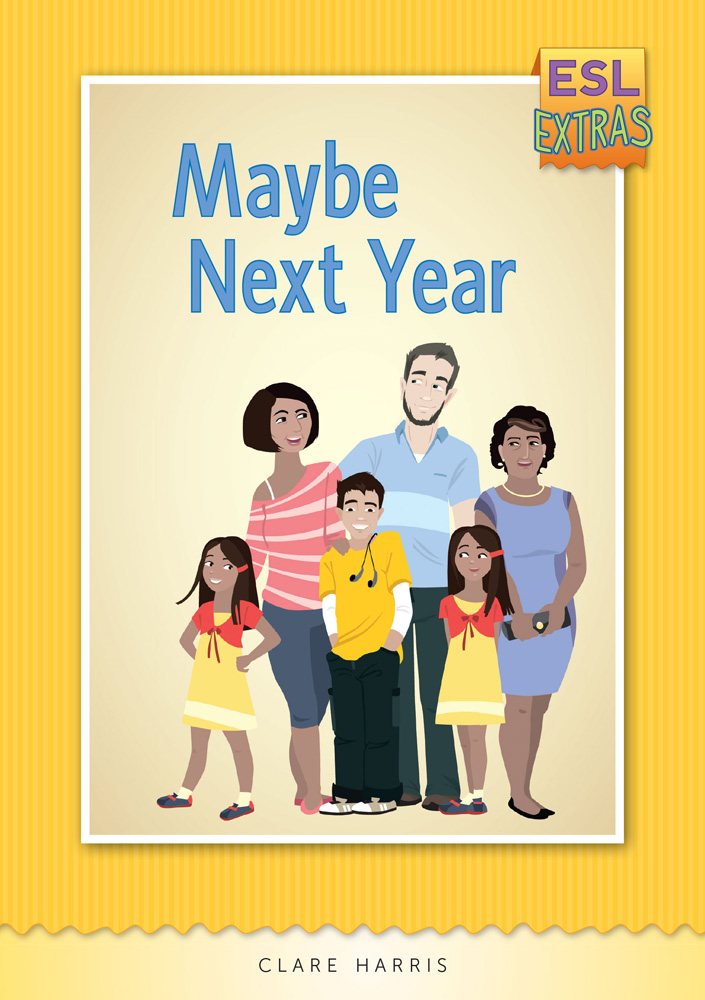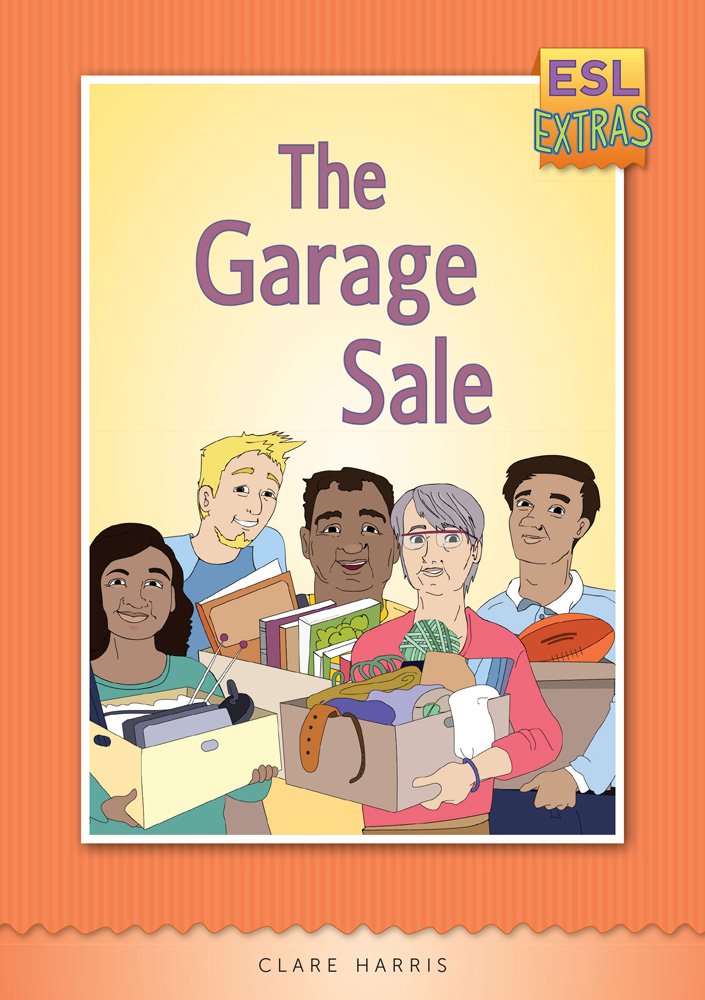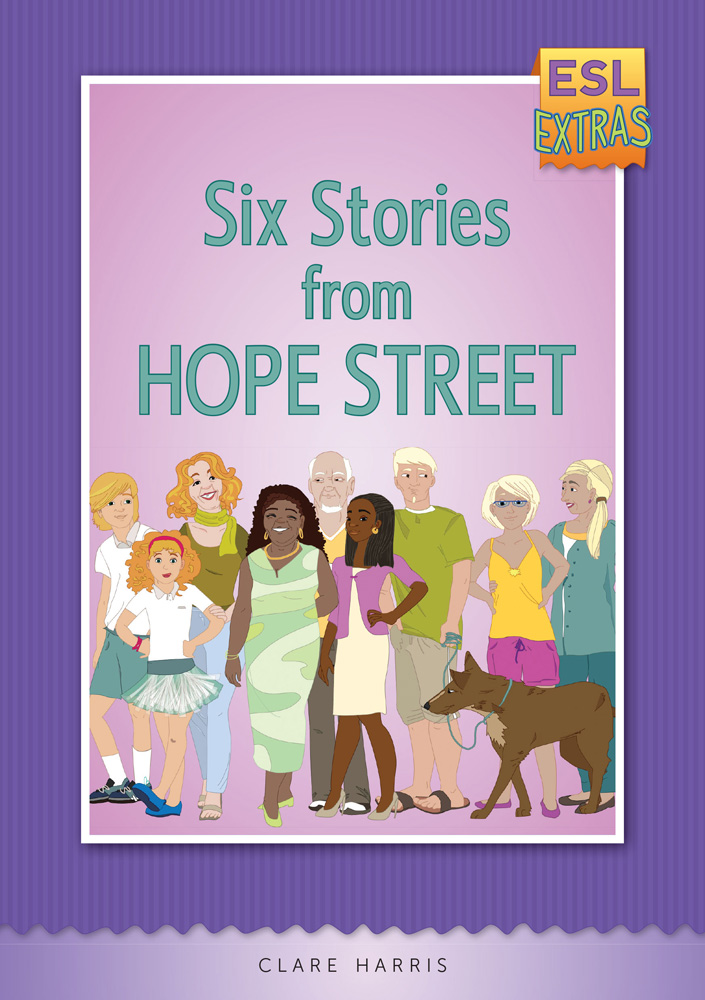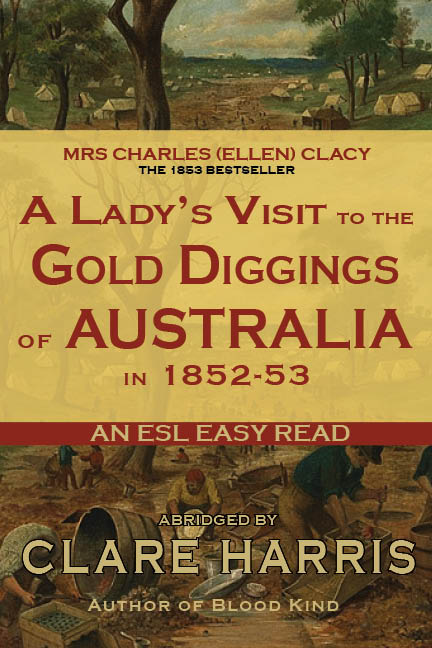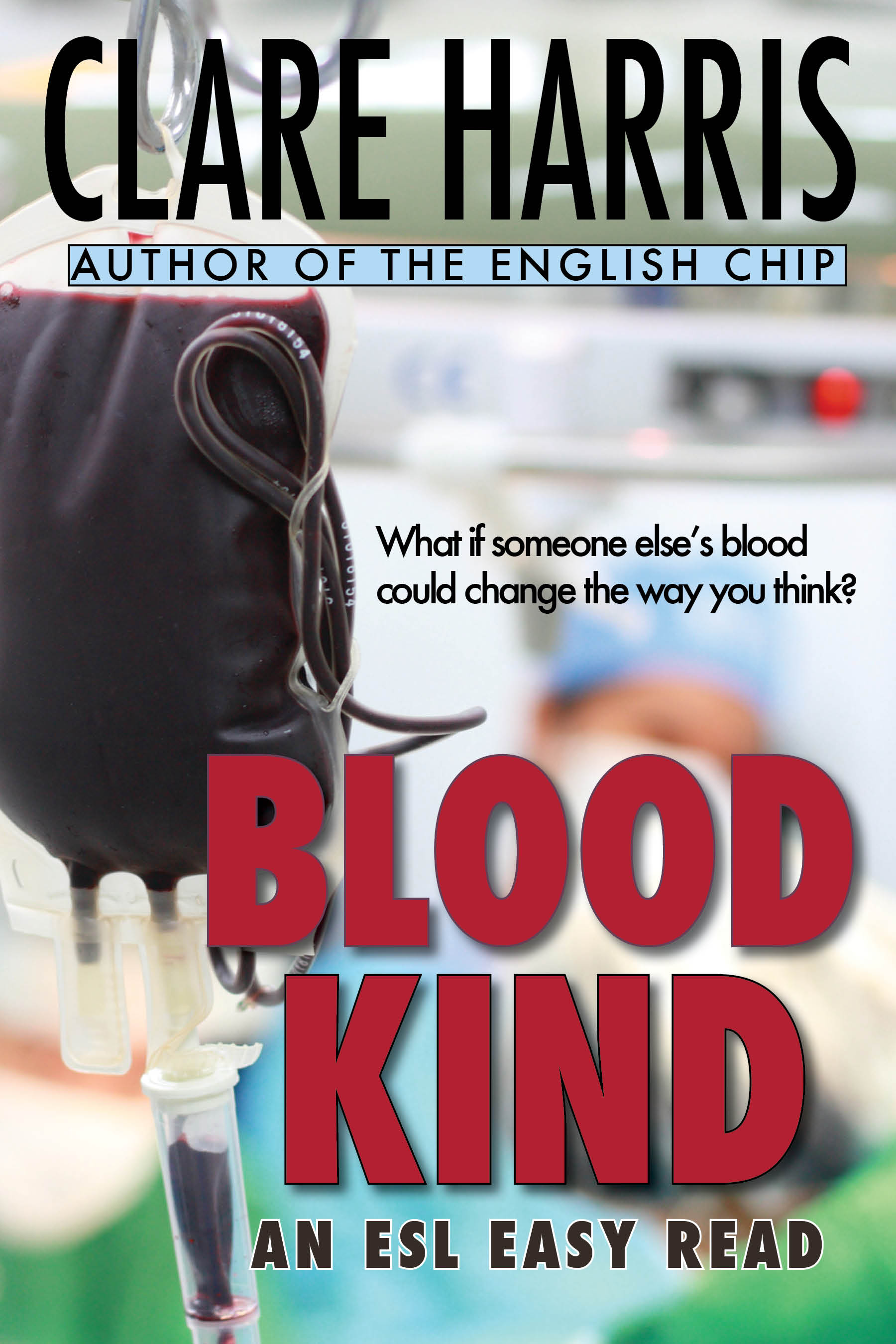Decodable readers for adult or young adult multilingual learners, anyone? It sounds like an obvious part of a literacy program, but they are SO hard to write as relatable stories, with meaningful context. (I say that as someone who has tried – and given up!)
So it was wonderful to discover that someone else has persisted – Lauren Piovesan, from ESL Reads. I asked her to tell me about her new Decodable series: reading books with support materials for the step-by-step stages of decoding and writing in English. You can see the progression of learning the ‘code’ from the first eight titles (in a much longer series):
A Mat, Nap on a Mat, The Big Pot, Dev is Hot, Lin and Kim Run, Liz has a Job, Yaz sells Rugs, Manj is Lost.
These covers show how these words can engage learners by reflecting their cultures.
So how did Lauren do this? And why embark on such a huge project, not just write a few ‘CVC’ readers? And how do these readers fit with her other levelled reading series? I had questions.
Lauren, how did you create real stories with such a limited word list?
That was hard for the initial code books, when just a few sounds have been taught. I looked at all the words available, and then looked for themes in the words, or for a name from another culture. Then with some stories like The Big Pot, I needed advice from an Aussie-Iraqi teacher, to make sure I had the context right.
I didn’t use all the words available, but I put extra words into the worksheet packs, so teachers can use them if they want to, as there are going to be learners with higher levels of oral language or who need additional practice. Everyone will be in a different situation.
And the pictures?
As you can see, I did some of the illustrations, and that was really helpful as it allowed me to tailor the pictures to show the context I wanted, with cultural relevance for learners. For example, another early word is mat, but this is not a yoga mat, but the mat that the family sits on to eat:
That’s so important. How do these decodable readers fit with your levelled readers? How would teachers use them?
Good question. The two types of readers target different reading skills. Most of the time, you’d be teaching a unit or topic, as a whole class activity, and this is where my original levelled series fits. The levelled readers focus on developing useful vocabulary, seeing grammar in context and developing comprehension skills. There are topics in these readers that are more likely to support teachers’ coursework. If learners can’t yet decode words in the pre-level 1 readers, then they can listen along with the audio, or do choral reading where they are supported. They’re still doing the language learning.
Then the decodables are helping with the specific reading skills?
Exactly. The decodables target phonemic awareness and decoding skills such as blending, segmenting and phoneme manipulation. Plus, if you use the worksheets, there are extras like letter formation, sentence reading and structure.
Won’t some learners pick up these skills themselves?
Of course, but we can’t rely on all learners picking up the 44 sounds of English, and 175 common spellings that go with the sounds – hence the value of learning to decode in a systematic way.
Teachers aren’t always sure about “phonics”…
It’s not easy for teachers, as decoding isn’t always supported in the curriculum. I was looking at the EAL Frameworks and could only find two units in Initial – nothing at Course or EAL 1. Yet I’ve found that even students in my post-beginner level class struggled with identifying and pronouncing vowel sounds, and spelling them.
So, considering there is no curriculum advice on what and how to teach English sounds, spellings and reading skills to EAL students, and in which order, it’s all up to the teacher to include information on spelling and graphemes and how our language works! And that’s a challenge.
Teachers are also pressed for time in class…
Yes, they are. I will say that teaching decoding skills (phonics) has been shown to be most effective when it’s short, sharp and regular – think half an hour a day, max! The results really make it worthwhile.
And the resources available?
Like all resources, decodable practice has to be meaningful and useful – and it has to avoid cognitive overload.
Unfortunately, a lot of decodable resources are for young learners, or for adults with high levels of oral English language skills. Apart from the fact that ‘kindy’ topics will be inappropriate, we all know that our learners don’t have the vocabulary knowledge assumed by most phonics programs.
This causes problems, and I think it makes teachers feel that using decodable readers is too hard. If you have words you can’t easily explain, or that are rarely going to be used by your learners given their stage of English, you can spend a lot of time and cognitive load just on the vocabulary. One word that kept coming up in early reader decodables was pit…
That’s fine if you live in a mining town like Kalgoorlie, with its Super Pit. “Pip is at the pit…”
Well, yes! But not for my learners.
There are adult decodable series from the UK, but they tend to start with more than 20 sounds at once. They’re not structured for complete beginners, but for learners who have mastered the ‘first half of the initial code’ and need practice.
Here in Australia, there are some great resources written with First Nations learners in mind, but they are written for children. That being said, I can remember a 17-year-old with no L1 literacy getting really excited by these, feeling he could be successful, but again, the content wasn’t quite relevant for him.
I recently got a message from a teacher who has used my new series, saying ‘These are the first adult-appropriate decodables I’ve been able to pick up and use without any adapting’. That’s exactly what I was hoping for, that they aren’t just useful for learners, but they also reduce the pressure on teachers.
What made you decide to take on this project?
I did a survey of teachers and half were happy with the resources they had, but half were not! I wrestled with it, because it wasn’t just about writing some engaging stories and trialling them.
I knew I needed more expertise, and that I’d have to decide which system I used. Then I’d be up for the cost of upskilling, paying consultants and sorting out licensing. Once you do decide on a particular system, there are guidelines to follow: which sounds you start with, and how many you introduce at a time – the ‘scope and sequence’. Then added to that I had to think of design and layout and how it could work digitally – it felt like a lot!
I’m amazed you persisted!
Well, in the end, it came down to an ethical and moral issue. I’ve worked in high schools as well as with adults, and I’ve seen too many students with 2-4 years in Australia who are still struggling to decode. They can read at a simple level, but they can’t cope with unknown words and with the texts they need to read in class.
This leads to disengagement with school, as well as extremely low self-esteem and a mirage of masking strategies they’ve had to work hard to develop in order to survive and save face in these contexts. They are excluded from learning and cannot experience success without serious modifications on the teacher’s part – and by that point, teens are reluctant to accept the modifications because of how it looks to their peers.
Oh yes, the whole issue of saving face as a teen…
Yes, and I’m also thinking of adults who get ‘stuck’ at a certain level and can’t progress through the curriculum levels because of literacy issues. This series is about encouraging teachers (through more palatable and suitable materials) to explicitly teach these skills so that these learners can experience success and so that we can empower learners with the skills to be literate and independent members of society.
So how did you decide which system to use?
In my teacher survey, I found that SoundsWrite was one of the most popular – it made sense to me. It starts with one letter, one sound, and CVC word structures, and slowly introduces introduces more complex sounds, spellings and word structures, all in microsteps.
Obviously students are still exposed to other letters and sounds in the rest of their class work, but the time working with decodables is when they’ll really focus on making it stick.
What support did you get?
I mentioned that I had to upskill, and in fact I just did a four-day training.
My support team were wonderful, though: two speech pathologists who are also working in the EAL space (one as a teacher). That was vital, to have that blend of skills, and they were both really supportive. I also owe a huge thanks to all the other teachers and learners who trialled and commented.
How long has this project taken (from first idea)?
Our first meeting was in January 2024 … that may not sound long, but it’s a long time for me.
Can any teacher use this?
Absolutely – but I would say the one thing is to check you have taught the sounds and vocabulary words represented in the unit before you use the decodables, so students have success. Or you could use them as revision. I’m hoping this will bridge the gap for teachers who are uncomfortable with using decodable texts, because they feel learners will find the vocabulary difficult or irrelevant to their needs, or not age appropriate or culturally appropriate And remember, it should just be a short session each time…
Tell me about the support materials?
That’s where you get the letter formation, morphology, grammar, vocabulary, spelling, comprehension and sentence work, so that the language is meaningful and useful. SoundsWrite doesn’t do handwriting, but I think that letter formation is really helpful for our emergent learners, to reinforce directionality.
That left to right direction is so hard for some learners…
Yes, it takes time. You have to keep reinforcing the direction, and Sounds-Write uses a lot of gestures to help with things like this. When I get the digital product done, that will be animated to move and show reading direction, to support those learners.
Digital! When will that be?
Well, I still have work to do to finish the Initial Code and onto the Extended Code. I wanted to release some readers early to let teachers have the chance to use them and get their feedback. I have eight readers out, hopefully six more by the end of the year, and another four early next year – that’s just the Initial Code. So Extended Code readers will come after that, as well as an interactive digital product with audio.
Allowing for practice at home?
Absolutely. Some students do need a lot more practice, but especially at beginner levels, there’s always that challenge of how to do it at home. That issue was a big catalyst behind the levelled series.
At the moment the decodable series has pdfs and worksheets available for all subscribers, but eventually there will be an interactive, e-learning module that learners can access out of class, just as they can access the levelled readers.
Sounds good. What kind of levels would you be using the Extended Code with?
Of course, it depends on the needs, and likely the education background or language background of your class. I would imagine that you could start Extended Code in Course in EAL and it would likely extend into EAL 1. You may be revising and revisiting spelling patterns e.g. for vowel sounds, or even extend some of the knowledge and skills for decoding polysyllabic words into EAL 2.
To start the extended code, students need to have really solid decoding skills (be able to blend and segment comfortably) for words with initial sounds and consonant digraphs (e.g. sh, th, ng, etc). If that’s not happening, even if students might have knowledge of the sounds and spelling patterns in the extended code (e.g. “ee’’ and “ea” for the long e sound), they shouldn’t start it unless they can decode and spell words with up to 5 initial sounds.
How can people find out more?
Subscribers already have access, and I’m busily updating my website to show what’s involved in the series. I’ll be doing some training in 2026, for teachers who are using this, and I’ll create a user guide for those who need more support. Please don’t hesitate to get in touch directly at admin@eslreads.com. I would love to hear from you if you have any questions.
Great good wishes with it, Lauren!



